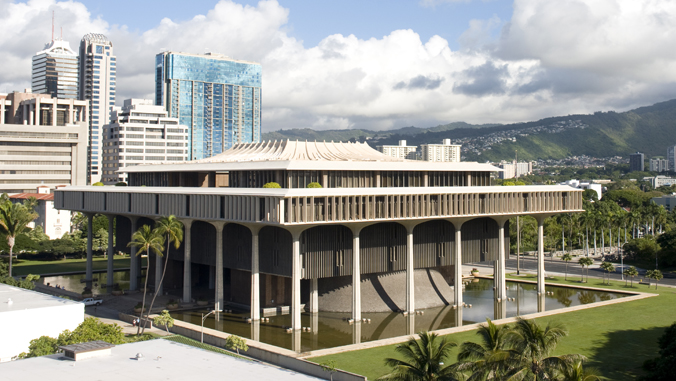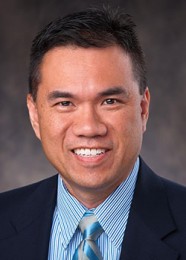
Kalbert Young, UH vice president for budget and finance and chief financial officer, shares his analysis of the 2020 legislative session.
The 2020 legislative session was like no other. Due to the impact of the COVID-19 pandemic, the session was interrupted in March and prolonged with a number of extended recesses and augmented calendars. Although originally scheduled to adjourn on May 7, the Legislature finally reconvened on June 22 and ended up adjourning sine die on July 10. Even with this extended calendar, the Legislature ended up with an abbreviated session, adjourning on the 53rd day out of a customary 60-day legislative session.
The shortened legislative session and the effects of COVID-19 impacts on nearly every aspect of life, society and the economy also affected the legislative business of crafting a budget, deliberating other important legislation, and addressing important public programs of our state. Nearly all of these efforts were sidetracked while having to endure the effects of the pandemic. As with nearly all areas in state government, the University of Hawaiʻi budget and legislative measures were a casualty of the pandemic during the legislative session.

For example, the university had two measures introduced that would help diversify the state’s economy and advance the university’s ability to encourage technology transfer and commercialization of university intellectual properties. These could help to mitigate our state’s reliance on the tourism industry by spurring increased entrepreneurship in other sectors. The intent of the measures was to remove “sunset provisions” that limit the duration of UH’s express statutory authority for its faculty and staff to engage in various programs and activities to support the innovation and commercialization of UH-based technologies. While both measures were progressing at the Legislature, once COVID-19 began impacting Hawaiʻi, both of these bills stalled and ended up failing to pass out of the Legislature. There is always next year.
Operating budget
While Hawaiʻi was experiencing a rather strong economy and the lowest unemployment rate in the country to start 2020, the impacts of the COVID-19 pandemic have since hit our state severely. Hawaiʻi now has one of the highest unemployment rates in the nation, and the state’s main economic driver—the visitor industry—will probably continue to struggle economically for the foreseeable near-term future.
In its May 29, 2020 forecast, the Council on Revenues noted the significant role that tourism plays in Hawaiʻi’s economy forecast and reduced the projected general fund revenue for the state by $793 million for fiscal year 2020 and another $1.89 billion for fiscal year 2021, a cumulative loss of $2.68 billion by the end of fiscal year 2021. All of these factors mean that the state has less revenue and funds to pay for government services, and the forecast is that conditions will worsen into the next fiscal year. As a result, all state budgets have been negatively impacted—including UH’s.
| Campus | Description | |||||||
|---|---|---|---|---|---|---|---|---|
| Board | Governor | Legislature | ||||||
| FTE | $$$ | FTE | $$$ | FTE (P) | FTE (T) | $$$ | ||
| Mānoa | UHealthy: Establish MD cohort on Maui | 8.00 | $1,400,000 | |||||
| Mānoa | UHealthy: Medical Education and Residency Support Program on Maui | 8.00 | $1,400,000 | |||||
| Mānoa | Athletics: Convert positions to General Fund | 43.00 | ||||||
| Mānoa | Mental Health: 5 Licensed Psychologists | 5.00 | $750,000 | |||||
| Hilo | Security: Complete the transition of security force to being completely comprised of civil service employees | 8.00 | $324,624 | |||||
| Hilo | New Program: BS in Aeronautical Sciences | 4.00 | $370,000 | |||||
| Hilo | Student Success: Case Manager, Retention Specialist, and Financial Aid Outreach Specialist | 3.00 | $180,000 | |||||
| Hilo | Student Success: Employ students as Learning Assistants, Peer Tutors, and Peer Advisors | $200,000 | ||||||
| Hilo | Mental Health: 1 Licensed Psychologist | 1.00 | $150,000 | |||||
| Hilo | Educational and Cultural Programming at Hale Pōhaku or other suitable venue, Maunakea Visitor Information Station, and ʻImiloa | 8.00 | $1,211,120 | 8.00 | $1,211,120 | |||
| West Oʻahu | Student Success: Admin Assistant for Early College transition and funds for Student Help Payroll | 1.00 | $347,000 | |||||
| West Oʻahu | Compliance, Food Sustainability, IT Specialist (Distance Ed), Travel/Hospitality Asst Prof | 4.00 | $272,000 | |||||
| West Oʻahu | New Programs: Creative Media & Facilities Management | 4.00 | $252,000 | 4.00 | $252,000 | |||
| West Oʻahu | 5 Security Officer, 1 Janitor, 1 Garden Manager, 1 Lab Manager | 8.00 | $368,000 | 3.00 | $200,000 | |||
| West Oʻahu | Mental Health: 1 Licensed Psychologist | 1.00 | $150,000 | |||||
| CCs | New Facilities: Kapiʻolani CC Culinary Institute of the Pacific Phase I. 1 Custodian, 1 General Laborer, utilities and facility maintenance costs | 2.00 | $465,780 | 2.00 | $465,780 | |||
| CCs | New Facilities: Leeward CC Waiʻanae Ed Center. 1 Custodian, 1 Security Officer, utilities and facility maintenance costs | 2.00 | $101,096 | 1.00 | $50,000 | |||
| CCs | New Facilities: Hawaiʻi CC Pālamanui Ed Center. 1 Custodian, 1 Building Maintenance Worker, 2 Security Officers, utilities and various maintenance costs. | 4.00 | $491,620 | 2.00 | $391,620 | |||
| CCs | Security: Positions and funds to provide 24/7 coverage at each campus. | 32.00 | $1,223,040 | 32.00 | $1,223,040 | |||
| CCs | Student Success: Hiring of Student Tutors and Mentors | $500,000 | ||||||
| CCs | Mental Health: 12 Licensed Psychologists | 12.00 | $1,600,000 | 6.00 | $800,000 | |||
| System | Hawaiʻi Promise Expansion to 4-year Institutions | $17,700,000 | $19,000,000 | |||||
| System | Office of Strategic Development & Partnerships – Project Coordinator | 1.00 | $100,000 | |||||
| Mānoa | Reduce vacant general funded position counts | (305.74) | (5.00) | |||||
| JABSOM | Reduce vacant general funded position counts | (19.57) | ||||||
| Hilo | Reduce vacant general funded position counts | (49.00) | ||||||
| West Oʻahu | Reduce vacant general funded position counts | (15.20) | ||||||
| CCs | Reduce vacant general funded position counts | (172.50) | (8.50) | |||||
| Aquaria | Reduce vacant general funded position counts | (4.00) | ||||||
| System | Reduce vacant general funded position counts | (53.00) | ||||||
| Total | 151.00 | $28,156,280 | 66.00 | $24,993,560 | (619.01) | (13.50) | ||
Given the current fiscal condition of the state, it is understandable for UH initiatives to not receive additional state funding support. However, the reduction of position counts does not generate any general fund savings for the state and will result in reduced ability to manage future operations. The position eliminations coincide with UH fiscal directives for systemwide hiring freezes and budget restrictions to address fiscal shortfalls stemming from COVID-19 impacts.
Lastly, although the university’s initiative to expand the Hawaiʻi Promise program to the four-year campuses was not part of the budget request, it did have some progress within the Legislature before COVID-19. For the last two years, this has been a UH legislative measure. It looks like that will have to continue next year, because the program to provide scholarship opportunities for students at the four-year campuses was tabled once COVID-19 impacted the session.
The governor has until September 15, 2020, to either sign, veto or allow bills to become law without his signature.

